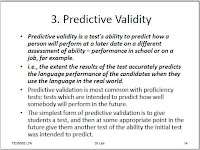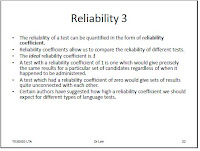Pawz asks you to draw
by: xanderalex
I have created a simple listening activity for you. Prepare a piece of A4 paper and also a pencil and when you are ready, hit the 'play' button. Happy Drawing!!!
* You can create one by clicking on this link
http://www.xtranormal.com
The listening test above can be done to test the listener's listening skill. Besides, it can also test the listener's vocabulary and comprehension.
Language Testing & Assessment
Saturday, 15 December 2012
Friday, 14 December 2012
Choose your character
Please take a look at the right side of my blog. Right at the "Point Me!!!" side.
You can try it here http://www.voki.com
You can try it here http://www.voki.com
My very first own mini junior!
Alex Junior Movie
by: xanderalex
I just experimented with this very exciting online application which can be used as a language teaching aid. I found out that it can attract learners' attention as you can really make a short movie based on what you want to be. In a simple word...you are the DIRECTOR!
The link for this exciting web is http://www.xtranormal.com
There is a few more exciting webpage which you can try on to discover something extra exciting.
http://voki.com/
http://www.englishcentral.com/videos#!/index
http://www.voxopop.com/
http://voicethread.com/
by: xanderalex
I just experimented with this very exciting online application which can be used as a language teaching aid. I found out that it can attract learners' attention as you can really make a short movie based on what you want to be. In a simple word...you are the DIRECTOR!
The link for this exciting web is http://www.xtranormal.com
There is a few more exciting webpage which you can try on to discover something extra exciting.
http://voki.com/
http://www.englishcentral.com/videos#!/index
http://www.voxopop.com/
http://voicethread.com/
Lets Paractice on
Criteria for Evaluating Language Tests
Criteria #1
VALIDITY
Criteria #2
RELIABILITY
Criteria #3
PRACTICABILITY
Criteria #4
There are FOUR criteria used for evaluating language test.
i) Validity
ii) Reliability
iii) Practicability
iv) Washback
VALIDITY
 |
| Page 1 (click picture to view) |
 |
| Page 2 (click picture to view) |
 |
| Page 3 (click picture to view) |
 |
| Page 4 (click picture to view) |
 |
| Page 5 (click picture to view) |
 |
| Page 6 (click picture to view) |
 |
| Page 7 (click picture to view) |
 |
| Page 8 (click picture to view) |
 |
| Page 9 (click picture to view) |
 |
| Page 10 (click picture to view) |
Criteria #2
RELIABILITY
 |
| Page 1 (click picture to view) |
 |
| Page 2 (click picture to view) |
 |
| Page 3 (click picture to view) |
 |
| Page 4 (click picture to view) |
 |
| Page 5 (click picture to view) |
 |
| Page 6 (click picture to view) |
 |
| Page 7 (click picture to view) |
 |
| Page 8 (click picture to view) |
 |
| Page 9 (click picture to view) |
 |
| Page 10 (click picture to view) |
 |
| Page 11 (click picture to view) |
 |
| Page 12 (click picture to view) |
Criteria #3
PRACTICABILITY
 |
| Page 1 (click picture to view) |
 |
| Page 2 (click picture to view) |
 |
| Page 3 (click picture to view) |
Criteria #4
WASHBACK
 |
| Page 1 (click picture to view) |
 |
| Page 2 (click picture to view) |
 |
| Page 3 (click picture to view) |
 |
| Page 4 (click picture to view) |
There are FOUR criteria used for evaluating language test.
i) Validity
ii) Reliability
iii) Practicability
iv) Washback
Thursday, 13 December 2012
Why so many types of test?
 |
| Sample tutorial to identify the purpose of test (click the picture to view) |
 |
| (cont...) sample tutorial to identify the purpose of test (click the picture to view) |
What comes to your mind when the word 'test' or 'assessment' is being spoke out? Is it a +ve one or is it a -ve one? Well, don't tell me. Here is a sample of an exercise to identify the purposes of various types of test. Try to answer the exercise. Good luck!!! :)
Tuesday, 4 December 2012
Reading Assessment
I've been 'experimented' with Google Doc. This is a reading assessment that I've created.
Based on the Bloom Taxonomy, the operational level for Question 1 is ‘knowledge’. The question requires the students to list down the name of places where primary area(s) of landslide incident in the United States occur. In order to do so the students must first remember or recall of what they had read before so that they are able to locate the information required even they are unable to remember about clearly. The second operational level for question 1 is ‘comprehension’. The students must have to understand the requirement of the question to enable them to answer the question correctly. They must be able to interpret the question accurately.
The operational level for question 2 is ‘comprehension’. It requires the students understanding on the sentence; to determine whether the given statement is true or not. When the students are able to understand the given statement then the students is able to start to check whether the given statement is true or not.
The operational level for question 3 is ‘comprehension’. As in question 2 the students must possess the understanding on the sentence or question requirement. After the students are able to identify the question’s objective, which is to choose the correct answer by identifying the category of landslide causes of the given causes of landslide.
There are two operational levels for question 4. The first one is ‘knowledge’. The students need to have the schemata of what is the possible reason(s) the causes of landslide at mountainous areas. If the students have the background knowledge it would be an easy task for the students to accomplish as they do not have to refer to the text.
There are two operational levels for question 5. The first one is ‘knowledge’. It is compulsory for the students to be able to have a wide vocabulary to be able to answer the question. The students must be able to come out with a specific term or word which have the same meaning as ‘a person killed or injured in a war or accident’. The second operational level for the question is ‘analysis’. The students must carefully read the article to find the exact term or word that can represent ‘a person killed or injured in a war or accident’.
There are also two operational levels for question 6. The first one is ‘analysis’. The students are required to separate the details between landslides cause by landslides and volcanic activity, landslides and seismic activity, and landslides and water and put them in an organizational way so that later on they can compare them easily in specific criteria, for example. The second operational level for the question is ‘evaluation’. The students are required to make judgement on the details that they have gotten and write it down.
Based on the Bloom Taxonomy, the operational level for Question 1 is ‘knowledge’. The question requires the students to list down the name of places where primary area(s) of landslide incident in the United States occur. In order to do so the students must first remember or recall of what they had read before so that they are able to locate the information required even they are unable to remember about clearly. The second operational level for question 1 is ‘comprehension’. The students must have to understand the requirement of the question to enable them to answer the question correctly. They must be able to interpret the question accurately.
The operational level for question 2 is ‘comprehension’. It requires the students understanding on the sentence; to determine whether the given statement is true or not. When the students are able to understand the given statement then the students is able to start to check whether the given statement is true or not.
The operational level for question 3 is ‘comprehension’. As in question 2 the students must possess the understanding on the sentence or question requirement. After the students are able to identify the question’s objective, which is to choose the correct answer by identifying the category of landslide causes of the given causes of landslide.
There are two operational levels for question 4. The first one is ‘knowledge’. The students need to have the schemata of what is the possible reason(s) the causes of landslide at mountainous areas. If the students have the background knowledge it would be an easy task for the students to accomplish as they do not have to refer to the text.
There are two operational levels for question 5. The first one is ‘knowledge’. It is compulsory for the students to be able to have a wide vocabulary to be able to answer the question. The students must be able to come out with a specific term or word which have the same meaning as ‘a person killed or injured in a war or accident’. The second operational level for the question is ‘analysis’. The students must carefully read the article to find the exact term or word that can represent ‘a person killed or injured in a war or accident’.
There are also two operational levels for question 6. The first one is ‘analysis’. The students are required to separate the details between landslides cause by landslides and volcanic activity, landslides and seismic activity, and landslides and water and put them in an organizational way so that later on they can compare them easily in specific criteria, for example. The second operational level for the question is ‘evaluation’. The students are required to make judgement on the details that they have gotten and write it down.
Subscribe to:
Comments (Atom)


